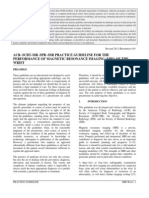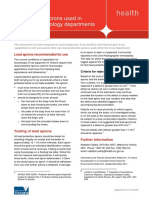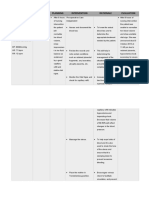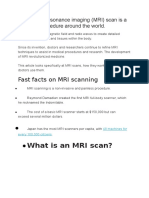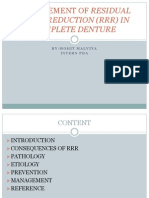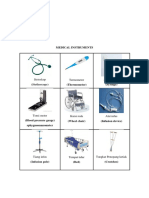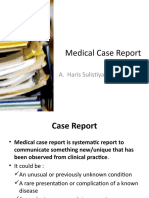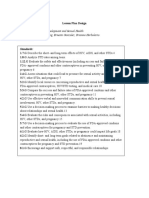Introduction to MRI (Magnetic Resonance Imaging)
Magnetic Resonance Imaging (MRI) is a non-invasive medical imaging technique used to create
detailed images of the organs and tissues within the body. It uses strong magnetic fields, radio
waves, and a computer to generate images without the use of ionizing radiation (like X-rays or CT
scans).
Key Features:
Magnetic Field: Aligns hydrogen atoms in the body.
Magnetic Field: Aligns hydrogen atoms in the body.
Radio Waves: Disrupt this alignment, and as atoms return to their normal state, they emit signals.
Computer Processing: Converts these signals into high-resolution images.
Uses of MRI:
Brain and spinal cord imaging.
Joint and musculoskeletal evaluations.
Heart and blood vessel assessments.
Tumor detection and cancer monitoring.
Abdominal and pelvic organ imaging.
Types of MRI:
MRI scans can be classified based on the body part being examined or the technique used. Here's
an overview of the main types:
A. Based on Body Region
1. Brain MRI
Used to detect tumors, stroke, multiple sclerosis, aneurysms, and other neurological conditions.
2. Spine MRI
Evaluates spinal cord injuries, herniated discs, infections, or tumors.
3. Musculoskeletal MRI
Focuses on joints, bones, ligaments, and soft tissues (e.g., knee, shoulder, wrist).
4. Cardiac MRI
Assesses heart structure and function, congenital heart defects, and myocardial damage.
5. Abdominal MRI
Mainly focus on the abdominal muscles and structure to identify the abnormalities.
6. Pelvic MRI
1
�Used for evaluating reproductive organs, prostate, bladder, and pelvic masses.
7. Breast MRI
Provides detailed images for breast cancer screening or evaluation, especially in high-risk patients.
B. Based on MRI Techniques
1. Functional MRI (fMRI)
Measures brain activity by detecting changes in blood flow; often used in neurology and brain
mapping.
2. Magnetic Resonance Angiography (MRA)
Visualizes blood vessels and detects aneurysms or stenosis.
3. Magnetic Resonance Venography (MRV)
Focuses on the venous system, often used for detecting deep vein thrombosis or venous
malformations.
4. Diffusion-Weighted Imaging (DWI)
Highlights water molecule movement; useful in early stroke detection.
5. Perfusion MRI
Evaluates blood flow to tissues, especially in tumor and stroke assessment.
6. Spectroscopy (MRS)
Analyzes chemical composition of tissues; often used in brain studies.
NOTE: MRI is especially valued for its ability to show both soft tissues and organs with great
clarity, making it vital in diagnosing a wide range of conditions.
PROCEDURE OF MRI
Patient Preparation for MRI
Proper preparation is essential to ensure safety and high-quality images during an MRI scan. Here
are the general steps involved in preparing a patient:
1. Medical History and Screening
Inform the radiologist or technician of any implants (e.g., pacemakers, cochlear implants, metal
clips).
Mention any history of surgeries, allergies, or kidney problems (especially if contrast dye will
be used).
2. Clothing and Personal Items
2
� Patients are usually asked to wear a hospital gown.
Remove all metal objects, including jewelry, watches, hairpins, eyeglasses, hearing aids, and
dentures.
Do not bring credit cards or phones into the MRI room, as the magnet can erase or damage
them.
3. Fasting
Fasting may be required if contrast material is used, typically 4-6 hours before the scan.
Sedation (if needed).
Claustrophobic or anxious patients may be given a mild sedative.
Children often require sedation to stay still during the scan.
5. Pregnancy
MRI is generally safe during pregnancy, but always inform the technologist if you are or might
be pregnant.
6. Contrast Agent Preparation (if applicable)
A contrast dye (like gadolinium) may be injected to enhance image quality.
Patients with kidney disease may need blood test to assess kidney function before contrast is
used.
Principle of MRI (Magnetic Resonance Imaging)
MRI is based on the principles of nuclear magnetic resonance (NMR), which involves the
interaction of magnetic fields and radiofrequency waves with the nuclei of atoms-in medical
imaging, primarily hydrogen atoms (found abundantly in water and fat). Key Steps in the MRI
Principle:
1. Strong Magnetic Field
A powerful magnetic field aligns the spin of hydrogen protons in the body.
2. Radiofrequency (RF) Pulse
A radiofrequency pulse is applied, temporarily knocking the protons out of alignment.
3. Relaxation and Signal Emission
When the RF pulse stops, the protons relax back to their original alignment, releasing energy in
the process. The energy emitted is detected as a signals.
4. Signal Processing
The MRI system measures the time it takes for protons to realign (called T1 and T2 relaxation
times) and converts this information into detailed images. Differences in tissue composition
3
�produce varying signals, allowing contrast between different types of tissues (e.g., muscle, fat,
fluid, tumors).
Pre-MRI Patient Care
Proper care before an MRI scan ensures patient safety and optimal image quality.
Here's a summary of key pre-scan care steps:
1. Patient Assessment
Review medical history, especially for:
Metal implants (e.g., pacemakers, aneurysm clips, cochlear implants)
Previous surgeries
Kidney disease (if contrast is used)
Allergies, especially to contrast agents
Pregnancy or breastfeeding status.
2. Patient Education
Explain the procedure, duration, and noise level during the scan.
Inform about the need to remain still for clear images.
Address claustrophobia concerns and discuss sedation options if necessary.
3. Fasting Instructions
If contrast dye is to be used, instruct the patient to fast for 4-6 hours beforehand (as per
institutional policy).
4. Clothing and Belongings
Ask the patient to wear a hospital gown.
Ensure removal of all metallic items, including:
Jewelry
Hairpins
Eyeglasses
Hearing aids
Dentures
Wallets and credit cards
5. Consent and Safety Screening
Obtain informed consent.
Complete a metal safety screening form.
For sedated patients, arrange for post-scan transportation.
6. IV Access (if needed)
4
� Prepare an IV line if contrast media is to be administered.
Intra-MRI Patient Care (During MRI Procedure)
Caring for the patient during the MRI scan is crucial to ensure safety, comfort, and image quality.
Here are the key aspects of intra-procedure care:
1. Patient Positioning
Position the patient comfortably and correctly on the MRI table
Use cushions, pads, or straps to minimize movement and maintain the correct posture.
2. Communication
Provide a call button or alarm to the patient in case they feel unwell or anxious.
Maintain two-way communication via intercom throughout the scan.
Reassure and update the patient periodically, especially during long scans.
3. Monitoring
Observe the patient continuously via the MRI-compatible camera system.
For sedated or high-risk patients, use MRI-compatible monitoring devices (heart rate, oxygen
saturation, etc.).
Ensure vital signs are stable if contrast is administered.
4. Noise Protection
Provide earplugs or headphones to reduce the loud noises produced by the scanner.
Motion Control
Remind the patient to stay still to avoid blurred images.
For pediatric or uncooperative patients, sedation may be required (administered and monitored
by a qualified professional).
6. Contrast Administration (if applicable)
Monitor the patient for allergic reactions or discomfort if contrast (e.g., gadolinium) is injected.
7. Ensure IV line patency throughout the procedure.
MRI is a non-invasive diagnostic imaging technique that uses strong magnetic fields and radio
waves to produce detailed images of the body's internal structures. It is especially effective for
soft tissues like the brain, muscles, and organs.
POST PROCEDURE CARE OF PATIENT:
Patients’ safety
IV access
Documentation
5
�SUMMERY:
Principle: Based on nuclear magnetic resonance of hydrogen atoms.
Common Uses: Brain, spine, joints, abdomen, heart, and cancer diagnosis.
Types: Brain MRI, cardiac MRI, fMRI, MRA, musculoskeletal MRI, etc.
Preparation: Screening for metal implants, fasting (if contrast used), removal of metal items.
Intra-care: Monitoring, communication, noise protection, and patient positioning.
Preparation: Screening for metal implants, fasting (if contrast used), removal of metal items.
Intra-care: Monitoring, communication, noise protection, and patient positioning.
MRI is considered safe and effective, though it requires precautions for patients with certain
implants or conditions.
CONCLUSION:
MRI is a powerful, safe, and non-invasive imaging technique that plays a critical role in modern
medical diagnosis. Its ability to provide high-resolution images of soft tissues without the use of
ionizing radiation makes it invaluable for evaluating a wide range of conditions, from neurological
disorders to musculoskeletal injuries and internal organ diseases.
With proper patient preparation and care, MRI offers accurate and detailed insights that aid in early
diagnosis, treatment planning, and follow-up. As technology continues to evolve, MRI will remain
a cornerstone of advanced diagnostic imaging. conditions, from neurological disorders to
musculoskeletal injuries and internal organ diseases.
REFERENCE:
1. Bushong, S. C. (2020). Magnetic Resonance Imaging: Physical and Biological Principles (5th
ed.). Elsevier Health Sciences.
2. Westbrook, C., Roth, C. K., & Talbot, J. (2018). MRI in Practice (5th ed.). Wiley-Blackwell.
3. Elster, A. D., & Burdette, J. H. (2001). Questions and Answers in Magnetic Resonance Imaging.
Mosby.
4. Kanal, E., Barkovich, A. J., Bell, C., Borgstede, J. P., Bradley, W. G., Froelich, J. W., ... &
Zaremba, L. A. (2013). ACR guidance document on MR safe practices: 2013. Journal of Magnetic
Resonance Imaging, 37(3), 501-530. https://doi.org/10.1002/jmri.24011
5. guidance document on MR safe practices: 2013. Journal of Magnetic Resonance Imaging, 37(3),
501-530. https://doi.org/10.1002/jmri.24011
6. Radiological Society of North America. (n.d.). MRI (Magnetic Resonance Imaging).
RadiologyInfo.org. Retrieved from https://www.radiologyinfo.org
6
�7



























